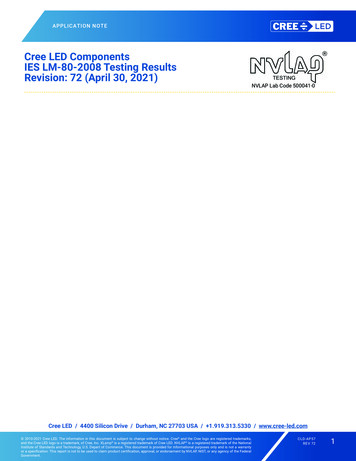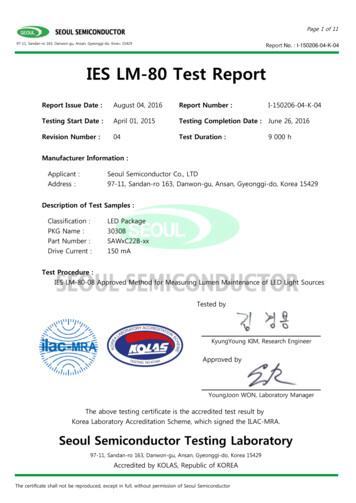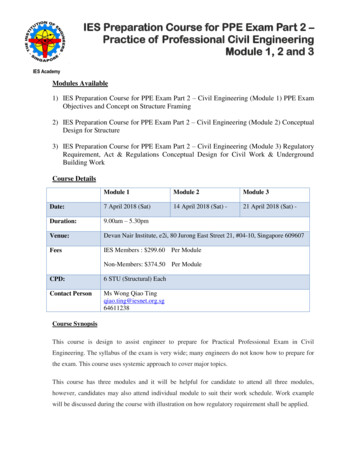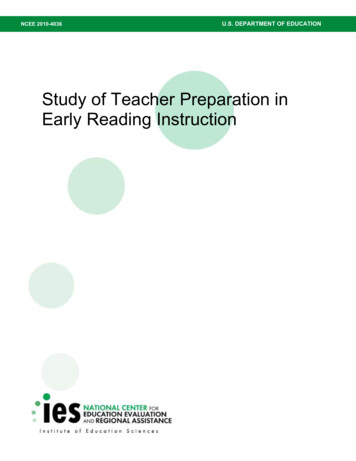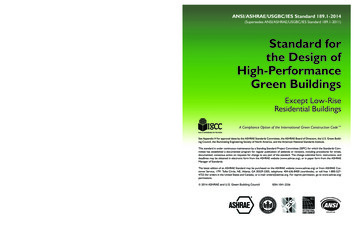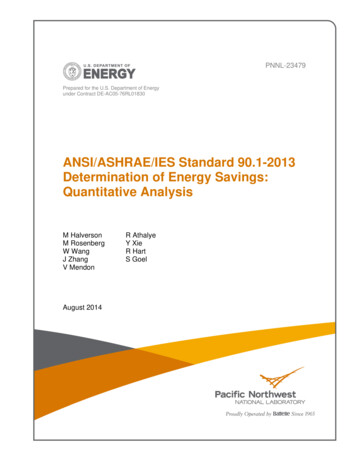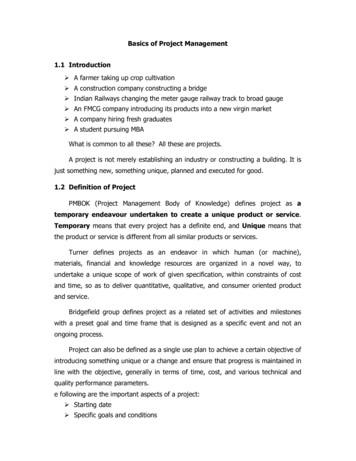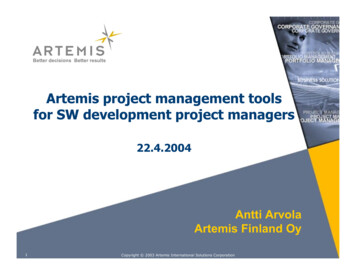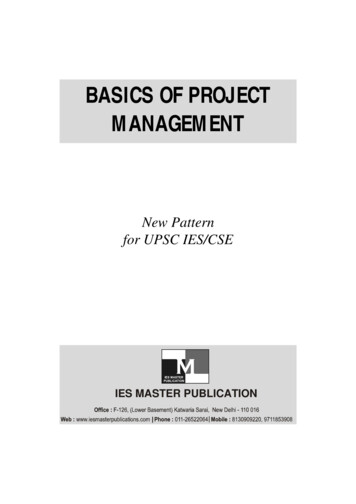
Transcription
BASICS OF PROJECTMANAGEMENTNew Patternfor UPSC IES/CSEIES MASTER PUBLICATION
IES MASTER PublicationF-126, Katwaria Sarai, Lower Basement New Delhi-110016Phone : 011-41013406, Mobile : 8130909220, 9711853908Web : www.iesmasterpublications.com E-mail :info@iesmaster.org No part of this booklet may be reproduced, or distributed inany form or by any means, electronic, mechanical, photocopying,or otherwise or stored in a database or retrieval system withoutthe prior permission of IES MASTER PUBLICATION, New Delhi.Violaters are liable to be legally prosecuted.First Edition : 2016Typeset at : IES Master Publication, New Delhi-110016
(iii)PrefacePreface to first EditionProject management is a method of planning the plan. It starts from Project definitionsand ends with goal achievement.Project management is both an art and a science.The science consists of a systematic approach using a standard methodology. Theart consists of “soft skills” including leadership, trust, credibility, problem solving, andmanaging expectations.A project manager who is skilled in the art instinctively knowshow and when to react toproject problems. Project manager successfully utilizesand refines both skill sets to effectively manage projects.The book “Basic of Project Management” has been written to address theneed of students appearing for UPSC Engineering Services Exam (ESE). Most ofthe books on this subject have been written too extensively and with a particularbranch of engineering in focus, which makes most of the part of the book irrelevantfor the exam. In this book we have tried to cover all the relevant topics pertinent tothe exam and have introduced important informations in boxes to attract specialattention and to clarify important concepts. Objective questions have been introducedat the end for practice and to discover the extent of students knowledge.IES Master Publication is thankful to Mr. Ankit Sharma for his extensivecontribution in generating, shaping, editing and production of this book. We alsothank the staff at IES Master Publication and all those who have assisted by providinginformations on the topics and advice in the production of the Book.IES Master PublicationNew Delhi, 2016
(v)CONTENTSPagesChapter-1Fundamental of Project Management01 – 28Chapter-2Process Group & Knowledge Areas29 – 40Chapter-3Project Initiation41 – 64Chapter-4Risk Analysis65 – 70Chapter-5Project PlanningChapter-6Project Monitoring & Control134 – 141Chapter-7Project Closing142 – 145Chapter-8Contract Management & Tendering Process146 – 193Objective Questions194 – 23071 – 133
(vii)TABLE OF CONTENTSSectionDescriptionPREFACEPage No. (iii)CONTENTS . (v)CHAPTER-1FUNDAMENTAL OF PROJECT MANAGEMENT1.1 Introduction1 – 2811.2What is Project?1.3Types of Projects41.3.1 Personal Project41.3.2 Business/Organisational Project51.3.3 National Projects51.3.4 Global Projects51.3.5 Based on Completion Time51.3.6 Based on Value of Project51.3.7 Based on Speed of Execution61.3.8 Based on Ownership61.4Characterstics of Projects61.5Operations1.6 Stakeholders81.6.1 Project Manager81.6.28Sponsor1.6.3 User/Customer81.6.4 Sellers or Business Partners91.6.5 Project Team91.6.6 Departmental Managers91.6.7 Board of Directors91.6.8 Project Management Office91.7Projectt Constraints91.8Why Project Management is needed?101.9What is Project Management?101.10 Objectives of Project management11
viiiCHAPTER-2CHAPTER-31.11 Project Management office111.12 Functions of Project Management121.13 Project, Program and Portfolio131.14 Project Manager151.15 Organisational Structure161.16 Types of Organisational Structure171.17 Project Lifce Cycle211.18 Phase to phase Relationship251.19 Types of Projects Life Cycles261.20 Project Success28PROCESS GROUP & KNOWLEDGE AREAS29 – 402.1 Introduction292.2What is “Process Groups”?302.3What is “Knowledge Areas”?312.4Process Groups322.5Knowledge Areas34PROJECT INITIATION41 – 643.1 Introduction413.2Project Identification and Prima Facie analysis423.3Project Preparation423.4Technical Feasibility433.4.1 Factors Considered in Technical Analysis433.5. Market Feasibility3.5.1.Demand Analysis483.5.2Demand Forecasting Techniques483.6. Financial Feasibility3.7.48523.6.1 Importance and Steps of Financial Feasibility523.6.2 Components of Cost of Project & its Estimation533.6.3 Working Capital Estimations553.6.4 Techniques of Capital Budgeting55Social Cost Benefit Analysis613.7.1 Social Costs613.7.2 Social Benefits633.864Detailed Project Report (DPR)
(ix)CHAPTER-4RISK ANALYSIS65 – 704.1 Introduction654.2Sources of Risk in Project Management654.3Managing Risk674.3.1 Identification of Risk684.3.2 Mapping out Causes of Risk & Constraints Involved 68CHAPTER-54.3.3 Quantifying the Eisk684.3.4 Develop the Alternatives:684.2.5 Selection of Best Alternative694.2.6 Creation of Risk Management Plan694.2.7 Implementation694.3.7 Review70PROJECT PLANNING71 – 1335.1Project Planning715.2Project Planning Steps715.2.1 Defining the Scope725.2.2 Work Breakdown Structure (WBS)725.2.3 Project Scheduling735.3Activity Over Arrow (A – O – A) Network Diagrams805.4Network Rules835.5Numbering of Events - Fulkerson’s Rule835.6Pert Analysis875.7Time Estimates885.8Frequency Distribution895.9Probability Distribution905.10 Normal Probability Distribution915.11 Beta Probability Distribution935.12 Expected Time (TE) of An Activity935.13 Expected Time for Activities in Series955.14 Event Time965.15 Slack975.16 Critical Path985.17 Probability of Completion of Project995.18 CPM Analsysis1055.19 Comparison106
xCHAPTER-6CHAPTER-75.20 CPM – Networks1065.21 Event Time1075.22 Start and Finish Times of Activity1085.23 Float 11095.24 Super Critical, Critical and Subcritical Activities1145.25 critical Path1155.261175.27 Project Cost1175.28 Indirect Cost1185.29 Direct Cost1185.30 Optimum Cost and Optimum Duration.1195.31 Cost Slope/Slope of Direct Cost Curve1205.32 Crashing1215.33 Resource Allocation1245.34 Important Points1255.35 Resource Levelling129PROJECT MONITORING & CONTROL134– 1416.1 Introduction1346.2What do we Monitor?1356.3Tools for monitoring and Control1356.3.1 S-Curve1356.3.2 Earned Value Analysis137PROJECT CLOSING142 – 1457.1 Introduction7.2 Main Objectives1421427.3Types of Project Closing1437.4Reasons for Pre-completion Termination of any Project1437.5Steps of Project Closing Process1447.6CHAPTER-8Estimation of Project CostProject Completion Audit1447.7Different Types of PCA1447.8Reasons for Failure of Projects145CONTRACT MANAGEMENT & TENDERING PROCESS8.18.2Definition and Objective8.1.1 Essential Features of a Contract AgreementContractual Approach146 – 193146147148
(xi)8.2.1 Traditional Build-Only Contracts1488.2.2 Design and Build Contracts1488.2.3 Build-Own Transfer (BOT) Contracts1498.2.4 Organisational Approach1498.2.5 Management Contract Approach1508.2.6 Professional Construction Management Approach 1508.2.78.3resources and Services Procurements Contract151Contract Documents1528.3.1 Notice Inviting Tender (NIT)1528.3.2 Contract Specifications1538.4Forms and Conditions of Contract1558.5Contract Types1568.5.1 Fixed Price/Lump-Sum Contracts1568.5.2 Cost-Plus-Fee Contracts157Types of Contracts in Common Use1578.6.1 Lumpsum Contracts1578.6.2 Measurement Contracts1588.7Choice of Types of Contract1598.8Pre Requisites of Execution of Work1608.8.1 Pre Construction and Construction Stages1608.10 Contracts for Specialist Works based on T and Q1658.68.10.1 Build-Operate Transfer/ Design-Build OperateApproach1658.10.2 Engineering-Procurement-Construction(EPC) / Lump Sum Turn Key Contract LSTK8.11 Specifications8.11.1Art of Writing Specifications8.12 Contract Stage1661671671718.12.1 Measures to Incorporate Genuine Materialin Works8.12.2 Passing and Inspection of Works1721738.12.3 Confidential Report on the Performance ofContractors1738.12.4 Extension of Time1748.12.5 Compensation for Delay1748.12.6 Suspensation of Work and Extension of Time1758.12.7 Interim Payments175
xii8.12.8Assesment of Value of Work Executed1758.12.9Causes Leading to Over Payment1758.12.10Deviation Orders and Amendment to Contract 1768.12.11 Completion of Work and Final Bill1768.12.12 Cancellation of Contract1768.13 Some Definitions1778.13.1 Mobilisation Advance1778.13.2 Yard Stick1778.13.3 Site Laborary1778.13.4 National Accreditation Board Testing and8.13.5Calibration Laboratories177Earnest Money1788.13.6 Bank Guarantee Bond1788.14 Post Contract Stage1798.14.1 Defects Liability Period1798.14.2 Arbitration1808.15 Contract Management1818.15.1 What is Contract Management?1818.15.2 Contract Management Trends1818.15.3 Building a Contract Management Team1828.15.4 Stakeholder Engagement1828.15.5 Resolving Conflicts1828.15.6 Corporate Governance1838.16 e-Tendering1838.16.1 What is Electronic-Procurement ore-Procurement?1838.16.2 What is Electronic Tendering or e-Tendering?1838.16.3 e-Tendering as a Contract Management Tool1848.17 FIDIC1898.17.1 The General Layout of the Contracts is as Follows1898.17.2 The Other Books1908.17.3 Characteristics of FIDIC1918.17.4 Application Prospect of FIDIC1928.17.5 FIDIC and Design/Build & EPC Turnkey Contracts193Objective Questions194 – 230
Project management is a method of planning the plan. It starts from Project definitions and ends with goal achievement.Project management is both an art and a science. The science consists of a systematic approach using a standard methodology. The art consists of “soft skills” including leadership, trust, credibility, problem solving, and managing expectations.A project manager who is .
